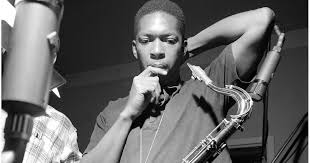
John Coltrane practiced for hours, using every conceivable rhythmic concept, including some that did not exist until that time. What he needed was a rhythm section that was both firm and adventurous. The "section" of Jimmy Garrison, McCoy Tyner, and Elvin Jones had worked with some of the most significant musicians in Jazz.
Jimmy Garrison was known for his big sound and a rock solid groove, but he was not viewed as forward looking, There were suggestions from other musicians that better known bass players would fill the bill, but Trane knew what he wanted. Garrison would be the pole at the center of the musical tent.
Elvin Jones was at a transition point when he was approached for the group. He was seen by many as forward looking, but lacking the control necessary for his polyrhythmic approach to work. He was transforming Jazz drumming, bringing it to a level that is still the standard today. He would support the band in the usual sense and he would play around the groove or leave it entirely if Trane went off into uncharted musical territory.
Coltrane's signature recording of "My Favorite Things" is a masterpiece of rhythm section playing. Simple as the tune is, it presented the rhythm section with a challenge. The song had only two chords, so Steve Davis (Garrison joined later) held the bottom down and and Pianist McCoy Tyner set up an insistent motif that never varied and Elvin played a lightly swinging waltz that became hypnotic as the song progressed through Coltrane's long solo.
The hypnotic groove became the essence of the quartet's sound. Much of his later work depended on the repetitive rhythms and drones of World Music. World Rhythms have their own internal swing that allowed the rhythm section to improvise, so long as one member kept the theme going.
You can hear this on "Africa Brass" where Elvin, now fully in command of his poly rhythmic approach digs into rhythms that could be found within 4/4 and 6/8. None of this would have been possible without the strong center held by Jimmy Garrison. Africa Brass is my favorite recording that features the rhythm section with a large ensemble at its best.
I wanted to leave the rhythmic contributions of pianist McCoy Tyner till last. He was known as a brilliant and subtle accompanist but who also could raise musical Hell when needed. Tyner used his power and subtlety to create many different dynamics, rhythms and colors that were necessary since he was the bands other major soloist.
This band would last about five years before the end came. The ending was sad as the beginning was hopeful. Coltrane loaded the band with other musicians. The music become so loud and noisy that the original group left one by one with only Jimmy Garrison staying to the end.
Coltrane would continue to perform and record but with musicians who did not have the cohesiveness nor the musical sense to perform with such a legendary and visionary artist.
The Groove continues
Stay Safe Everybody
 RSS Feed
RSS Feed
